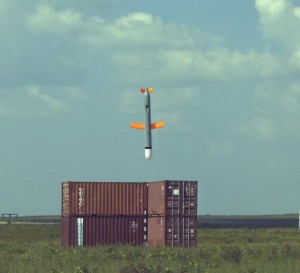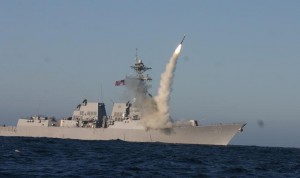Tomahawk is an all-weather submarine or ship-launched land-attack cruise missile. After launch, a solid propellant propels the missile until a small turbofan engine takes over for the cruise portion of flight. Tomahawk is a highly survivable weapon. Radar detection is difficult because of the missile’s small cross-section, low altitude flight. Similarly, infrared detection is difficult because the turbofan engine emits little heat. Systems include Global Positioning System (GPS) receiver; an upgrade of the optical Digital Scene Matching Area Correlation (DSMAC) system; Time of Arrival (TOA) control, and improved 402 turbo engines.
The Tomahawk land-attack cruise missile has been used to attack a variety of fixed targets, including air defense and communications sites, often in high-threat environments. The land attack version of Tomahawk has inertial and terrain contour matching (TERCOM) radar guidance. The TERCOM radar uses a stored map reference to compare with the actual terrain to determine the missile’s position. If necessary, a course correction is then made to place the missile on course to the target. Terminal guidance in the target area is provided by the optical Digital Scene Matching Area Correlation (DSMAC) system, which compares a stored image of target with the actual target image.
Tomahawk Operational Use
Two submarines and a number of surface ships fired Tomahawk cruise missiles during the Gulf War. According to initial US Navy reports, of 297 attempted cruise missile launches, 290 missiles fired and 242 Tomahawks hit their targets. But TLAM performance in Desert Storm was well below the impression conveyed in DOD’s report to the Congress, as well as in internal DOD estimates. During Desert Storm, a TLAM mission was loaded 307 times into a particular missile for launch from a Navy ship or submarine. Of those 307, 19 experienced prelaunch problems. Ten of the 19 problems were only temporary, thus these missile were either launched at a later time or returned to inventory. Of the 288 actual launches, 6 suffered boost failures and did not transition to cruise. Despite initial strong positive claims made for TLAM performance in Desert Storm, analysis of TLAM effectiveness was complicated by problematic bomb damage assessment data. The relatively flat, featureless, desert terrain in the theater made it difficult for the Defense Mapping Agency to produce usable TERCOM ingress routes, and TLAM demonstrated limitations in range, mission planning, lethality, and effectiveness against hard targets and targets capable of mobility.
The Gulf War and subsequent contingency operations, including the September 1996 attacks on Iraqi military installations, demonstrated that long-range missiles can carry out some of the missions of strike aircraft while they reduce the risk of pilot losses and aircraft attrition.
Block III, with its improved accuracy and stand alone GPS guidance capability, was first used in the September 1995 Bosnia strike (Deliberate Force) and again in the September 1996 Iraq strike (Desert Strike). Success rates for both strikes were above 90%. In all, Tomahawks firing power shows a greater than 85% success rate
Specifications
Primary Function: Long-range subsonic cruise missile for striking high value or heavily defended land targets.
Contractor: Raytheon Missile Systems Company, Tucson, AZ
Date Deployed: Block II TLAM-A IOC – 1984
Block III – IOC 1993
Block IV – IOC 2004
Unit Cost: Approximately $607,000 (FY99 $).
Propulsion: Block II/III TLAM-A, C & D – Williams International F107 cruise turbo-fan engine ; ARC/CSD solid-fuel booster
Block IV TLAM-E – Williams International F415 cruise turbo-fan engine ; ARC MK 135 Rocket Motor Asssembly
Length: 20.3 feet
Diameter: 21 inches
Wingspan: 8 feet 9 inches
Weight: 3,330 lbs with rocket motor
Speed: Subsonic
Range: Block II TLAM-A – 1350 nautical miles (1500 statute miles, 2500 km)
– Block III TLAM-C – 900 nautical miles (1000 statute miles, 1600 km)
– Block III TLAM-D – 700 nautical miles (800 statute miles, 1250 km)
– Block IV TLAM-E – 900 nautical miles (1000 statute miles, 1600 km).
Guidance System: Block II TLAM-A – INS, TERCOM
Block III TLAM-C, D & Block IV TLAM-E – INS, TERCOM, DSMAC, and GPS.
Warhead: Block II TLAM-N – W80 nuclear warhead
– Block III TLAM-C and Block IV TLAM-E – 1,000 pound class unitary warhead
– Block III TLAM-D – conventional submunitions dispenser with combined effect bomblets.
References:
http://www.fas.org/man/dod-101/sys/smart/bgm-109.htm


